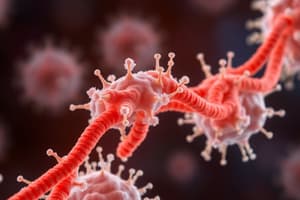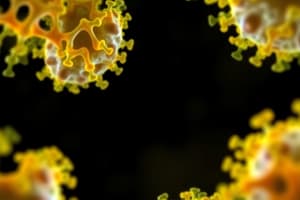Podcast
Questions and Answers
What is the role of small regulatory RNAs like siRNAs in gene regulation?
What is the role of small regulatory RNAs like siRNAs in gene regulation?
- They promote transcription factor binding.
- They enhance mRNA translation.
- They directly bind to ribosomes.
- They degrade target mRNA when perfectly matched. (correct)
What occurs during X-inactivation in female mammals?
What occurs during X-inactivation in female mammals?
- All genes on the X chromosome are expressed.
- Both X chromosomes are activated.
- X-linked traits are lost.
- One X chromosome is silenced. (correct)
How does the protein transferrin function in iron metabolism?
How does the protein transferrin function in iron metabolism?
- It degrades excess iron.
- It stores iron in the liver.
- It promotes the synthesis of hemoglobin.
- It transports iron in the bloodstream. (correct)
What mechanism does translational regulation primarily affect?
What mechanism does translational regulation primarily affect?
What role do enhancer and silencer sequences play in gene regulation?
What role do enhancer and silencer sequences play in gene regulation?
What is the function of ferritin in iron metabolism?
What is the function of ferritin in iron metabolism?
What is a potential outcome of transcriptional control by regulatory transcription factors?
What is a potential outcome of transcriptional control by regulatory transcription factors?
What occurs when an mRNA binds to miRNA/RISC complex?
What occurs when an mRNA binds to miRNA/RISC complex?
What is the primary reason that different cell types in the human body can perform distinct functions despite sharing the same genetic material?
What is the primary reason that different cell types in the human body can perform distinct functions despite sharing the same genetic material?
How is gene expression regulated at the epigenetic level?
How is gene expression regulated at the epigenetic level?
What happens to DNA when chromatin is tightly coiled?
What happens to DNA when chromatin is tightly coiled?
Which of the following describes the process of DNA methylation?
Which of the following describes the process of DNA methylation?
What type of stem cell can differentiate into any cell type and extraembryonic tissues?
What type of stem cell can differentiate into any cell type and extraembryonic tissues?
What is the result of histone tail modifications referred to as the 'histone code'?
What is the result of histone tail modifications referred to as the 'histone code'?
Which type of stem cells can give rise to a limited range of specialized cell types?
Which type of stem cells can give rise to a limited range of specialized cell types?
What is a characteristic of epigenetic changes in gene expression?
What is a characteristic of epigenetic changes in gene expression?
Flashcards
Stem Cell
Stem Cell
A special type of cell that can differentiate into various cell types.
Pluripotent
Pluripotent
A cell with the potential to differentiate into any cell type of the body.
Totipotent
Totipotent
A cell able to differentiate into any cell type, including extraembryonic structures and the placenta.
Multipotent
Multipotent
Signup and view all the flashcards
Gene Regulation in Eukaryotes
Gene Regulation in Eukaryotes
Signup and view all the flashcards
Epigenetic Effects
Epigenetic Effects
Signup and view all the flashcards
Histone Tail Modifications
Histone Tail Modifications
Signup and view all the flashcards
DNA Methylation
DNA Methylation
Signup and view all the flashcards
Gene Silencing in Differentiation
Gene Silencing in Differentiation
Signup and view all the flashcards
Reprogramming Cells
Reprogramming Cells
Signup and view all the flashcards
Induced Pluripotent Stem (iPS) Cells
Induced Pluripotent Stem (iPS) Cells
Signup and view all the flashcards
Chromosome Regulation
Chromosome Regulation
Signup and view all the flashcards
X-Inactivation
X-Inactivation
Signup and view all the flashcards
Transcriptional Control
Transcriptional Control
Signup and view all the flashcards
Regulatory Transcription Factors
Regulatory Transcription Factors
Signup and view all the flashcards
Small Regulatory RNAs (siRNAs, miRNAs)
Small Regulatory RNAs (siRNAs, miRNAs)
Signup and view all the flashcards
Study Notes
Regulation of Gene Expression in Eukaryotes
- Eukaryotic cells control gene expression at multiple levels
- Humans have ~200 major cell types, yet share the same genome
- Different cell types express different sets of genes
Eukaryotic Gene Regulation
- Cells control gene expression through epigenetic, transcriptional, and translational control
Chromatin Remodeling
- DNA in chromatin is inaccessible to the transcription machinery until remodeled
- Tightly coiled chromatin limits access to promoters/enhancers
- Chemical modifications of histone tails reposition nucleosomes and expose DNA to the transcription machinery.
- This occurs during development and in response to environmental cues
Histone Tail Modifications
- Histone code affects chromatin structure and gene transcription.
- The modifications include methylation (mono, tri, etc), acetylation
DNA Methylation
- Light methylation of CpG islands allows transcription.
- Heavy methylation of CpG islands inhibits transcription.
- DNA methylation can recruit proteins to remodel chromatin and modify histone tails
Epigenetic Effects
- Epigenetic effects are changes in gene expression without changing DNA sequence
- These changes can be inherited but often are reversible and responsive to environmental changes
Epigenetic Adaptations
- Environmental toxins, stress, smoking, diet, and aging can influence epigenetic adaptations, impacting subsequent generations
- Epigenetic disorders and epigenetic-based therapies can be used
Repressed vs. Active Chromatin
- Repressed chromatin is heavily methylated and is associated with deacetylated and methylated histones
- Active chromatin is lightly methylated and associated with acetylated and deacetylated histones
- Histone acetylation and methylation can change the structure of DNA, enabling or preventing transcription
X-inactivation
- X-inactivation occurs in the early embryo, often around the time of implantation
- In each cell linage, the inactivated X chromosome remains inactivated
- The Xist gene is transcribed, and the Xist RNA binds to the X-chromosome in the inactivation center, effectively inactivating the X-chromosome
Transcriptional Control
- General transcription factors bind the promoter
- Transcriptional activator proteins bind to enhancers
- DNA looping brings these factors together, allowing transcription
Regulatory Transcription Factors
- Regulatory transcription factors bind to DNA sequences
- These sequences are called enhancers or silencers
- Activators or repressors can bind to these sequences to turn on or off gene expression, influencing transcription
- These sequences can be located far from promoters but still affect transcription
Translational Regulation: Small Regulatory RNAs
- Precursors of small regulatory RNAs (e.g., siRNAs, miRNAs) are processed in the cytoplasm
- These fragments target complementary mRNA sequences through translational inhibition
- siRNAs pair perfectly with a target mRNA resulting in degradation of the mRNA
- miRNAs have mismatches leading to translational inhibition
Translational Regulation: Proteins that Bind UTRs
- Proteins can bind to sequences in the 5' and 3' untranslated regions (UTRs) of mRNA
- These proteins influence the location and regulation of translation initiation.
- This impact mRNA stability
Post-transcriptional Regulation of Gene Expression
- Iron-response element activity is regulated to ensure appropriate iron levels for cell function
- These factors regulate various cellular processes, including gene expression, translation and mRNA stability.
- The most common mechanism of translational regulation is initiation.
- Binding proteins can block ribosomes.
Gene Regulation- Iron Metabolism
- Humans require iron for red blood cell production (-20 mg/day).
- Excessive iron is toxic
- Iron transport proteins (transferrin, transferrin receptors) and storage protein (ferritin) are critical
Elements of Iron Response
- mRNA for ferritin and transferrin receptor have iron response elements (IRE)
- Binding proteins (IRE-BPs) modulate mRNA stability and translation based on iron levels.
- Iron-dependent conformation changes of IRE-BP control when the mRNA is translated
Studying That Suits You
Use AI to generate personalized quizzes and flashcards to suit your learning preferences.
Related Documents
Description
Explore how eukaryotic cells regulate gene expression at various levels, including epigenetic, transcriptional, and translational controls. This quiz covers key concepts such as chromatin remodeling and histone tail modifications that impact gene transcription.





